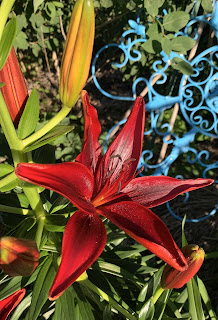 |
| 'Kaveri' |
It is high time (well, not "High Times" in terms of the magazine of that name, but high time in relation to being the proper time) for ProfessorRoush to report the results of a commercially-initiated experiment, that of my experience with the 'Kaveri' bulbs.
As I reported earlier, I received 5 bulbs this Spring from Garden Media Group for evaluation by and had planted them shortly after arrival.
'Kaveri' lily is a brand new cross between Asiatic lilies and Oriental lilies (OA) that was introduced by Longfield Gardens. Sources describe it as being fragrant, to produce 6-8 flower buds that open into upward-facing blooms, and to grow up to 40 inches tall. While I admit that I was not and still am not excited about the orange and red color mixture of 'Kaveri' itself, I was intrigued by the interspecific cross. I grow a number of Orientpet lilies, the interspecies hybrids of Oriental and Trumpet lilies, and because Asiatic lilies grow well here, I was hoping for a similar happy experience with 'Kaveri'.

My five bulbs, planted immediately into the alkaline soil of Kansas and then watered excessively by the very wet and cool spring we experienced, resulted in two full-grown lilies with open blooms. Of the three "failures," one bulb failed to come up, one came up and then fizzled eventually in the rain, and the third was trampled by Bella when it was a foot tall. All in all, not a spectacular result, but about par for the course for a typical plant trial in Kansas clay. They bloomed just past the peak of the Asiatic lilies in my garden, and are probably one to two weeks ahead of any of my Oriental lilies. They thus fill an important niche bloom time between the species, and their bloom in my garden coincides with the peak of the daylily cultivars.
These two mature lilies are both 31" tall and each has 5 blooms or buds ready to open. I presume the number of buds will increase over the next couple of years to the expected 6-8. The blooms are quite large, approximately 6 inches across, reflecting Oriental lily size more than Asiatic, and the petals are likewise thick and waxy like their Oriental ancestors. They do face forward and up and a mature clump should make a nice statement in a garden. And they ARE fragrant, but pleasantly so in my opinion. Their fragrance is sweet, like an Oriental lily but happily not nearly as thick or cloying as the latter, and it doesn't carry more than a couple of feet away. Since I can't be in the same room with more than a single bloom of a strong Oriental lily, and sometimes not even that, I'm happy that 'Kaveri' keeps its fragrance available when I want it, instead of smothering me with it.

It may be obvious from the above comments that I like the idea of an OA hybrid, but I wasn't excited by the particular color of 'Kaveri' itself. While there is certainly no accounting for taste, I hope for my own tastes that the future brings other colors into this mix, because I really prefer the quieter colors of the Orientals over the brash colors of the Asiatics. I could only find one more OA hybrid on a quick internet search, 'Sunny Crown' and it looks much like 'Kaveri', perhaps with less orange centers and more yellow margins.
Alas, in further reading, I found that the F1 hybrids of Oriental and Asiatic lilies are all sterile due to lack of chromosome pairing, and so they cannot be used for further cross-breeding without modification. Leave it to scientists, however to find a solution; it seems that doubling the number of chromosomes with colchicine allows the polyploid progeny to produce some backcrosses that hold promise for the future. A future bright, I hope, with fragrant-but-not-too-fragrant OA lilies that are pink or white.
All that being said, I do think 'Kaveri' is a nice accent for my reading garden statue, don't you agree?














.jpg)
.jpg)
.jpg)
.jpg)
.jpg)